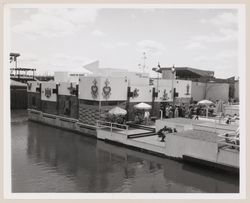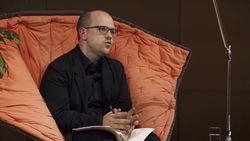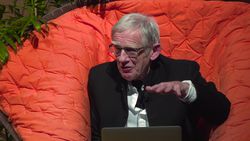Project
La nuova piazzetta Manzoni
AP142.S1.D129
Description:
File documents an executed project for a plaza outside the Manzoni subway station, on Croce Rossa Street, Milan, Italy. The plaza notably comprises a large fountain monument (edified on the memory of Alessandro Pertini), which was heavily criticized by the public. Material in this file was produced between 1988 and 1990. File contains a reference drawing, conceptual drawings, design development drawings and presentation drawings. File also contains textual records, including correspondence, specifications, clippings on the project's controversy, promotional material, sketches, drawings and photographic material.
1988-1990
La nuova piazzetta Manzoni
Actions:
AP142.S1.D129
Description:
File documents an executed project for a plaza outside the Manzoni subway station, on Croce Rossa Street, Milan, Italy. The plaza notably comprises a large fountain monument (edified on the memory of Alessandro Pertini), which was heavily criticized by the public. Material in this file was produced between 1988 and 1990. File contains a reference drawing, conceptual drawings, design development drawings and presentation drawings. File also contains textual records, including correspondence, specifications, clippings on the project's controversy, promotional material, sketches, drawings and photographic material.
File 129
1988-1990
Research Fellow Seminar: Irene Brisson
Lakay se Lakay: Transnational Architectures of Belonging
Shaughnessy House Keyword(s):
research fellow 2022, Irene Brisson, Haiti, lakay, diaspora, belonging, memory, creole, kréyol, bòsmason, creolization
4 August 2022, 6pm
Shaughnessy House Keyword(s):
research fellow 2022, Irene Brisson, Haiti, lakay, diaspora, belonging, memory, creole, kréyol, bòsmason, creolization
Project
AP164.S1.2003.D7
Description:
The project series documents Abalos & Herreros’ entry for an open competition for the national library José Vasconcelos, Mexico city, Mexico. The firm identified this project as number 170. “The central library is a county’s visible deposit for its culture, a legacy to the future; contemplating al [sic] periods of a culture in a holistic and integrated way crosses historic earas [sic] and puts human memory in relation to geological time, a substrate which shelters and protects human life. [The] library will establish this dialogue by anchoring in the site, the city and the country by basic gesture putting the geologic substrate, the lagoon and the volcanos which construct and nourish the earth as a relief. A lagoon perforated by seven craters composes the germlike landscape which starts the projects, giving us a first drawing which transforms the space almost into a lake of waterlilies.” (ARCH270975) Documenting the project are conceptual drawings, competition documents, resumes, correspondence and a map.
2001-2003
Biblioteca de México, Mexico City, Mexico
Actions:
AP164.S1.2003.D7
Description:
The project series documents Abalos & Herreros’ entry for an open competition for the national library José Vasconcelos, Mexico city, Mexico. The firm identified this project as number 170. “The central library is a county’s visible deposit for its culture, a legacy to the future; contemplating al [sic] periods of a culture in a holistic and integrated way crosses historic earas [sic] and puts human memory in relation to geological time, a substrate which shelters and protects human life. [The] library will establish this dialogue by anchoring in the site, the city and the country by basic gesture putting the geologic substrate, the lagoon and the volcanos which construct and nourish the earth as a relief. A lagoon perforated by seven craters composes the germlike landscape which starts the projects, giving us a first drawing which transforms the space almost into a lake of waterlilies.” (ARCH270975) Documenting the project are conceptual drawings, competition documents, resumes, correspondence and a map.
Project
2001-2003
Project
AP178.S1.1983.PR01
Description:
This project series documents the Reconstrução da Igreja Madre de Salemi, the Piazza Alicia and the Recuperação do Plano Cascio in Salemi, Italy. While the records were held in the office’s archives this project was assigned the number [7]/80. The office assigned the dates 1983-1999 for this project. The reconstruction of the mother Church of Salemi, the construction of the Piazza Alicia, and the rehabilitation of Plano Cascio was part of an urban renewal for Salemi. In 1968, an earthquake destroyed the Igreja Madre de Salemi and damaged the area. The church was never rebuilt. In 1982, Roberto Collovà and Siza we're chosen by the Curia of Mazara del Vallo for the reconstruction of the church. Instead of rebuilding it, the architects decided to use the ruins to create something new that would represent the spirit of the church and the memory of the earthquake. Documenting this project are plans, project documentation, and correspondence. Photographic materials document construction work and the model.
1984-1992
Reconstrução da Igreja Madre de Salemi [Reconstruction of the Mother Church of Salemi], Salemi, Italy (1983-1999)
Actions:
AP178.S1.1983.PR01
Description:
This project series documents the Reconstrução da Igreja Madre de Salemi, the Piazza Alicia and the Recuperação do Plano Cascio in Salemi, Italy. While the records were held in the office’s archives this project was assigned the number [7]/80. The office assigned the dates 1983-1999 for this project. The reconstruction of the mother Church of Salemi, the construction of the Piazza Alicia, and the rehabilitation of Plano Cascio was part of an urban renewal for Salemi. In 1968, an earthquake destroyed the Igreja Madre de Salemi and damaged the area. The church was never rebuilt. In 1982, Roberto Collovà and Siza we're chosen by the Curia of Mazara del Vallo for the reconstruction of the church. Instead of rebuilding it, the architects decided to use the ruins to create something new that would represent the spirit of the church and the memory of the earthquake. Documenting this project are plans, project documentation, and correspondence. Photographic materials document construction work and the model.
Project
1984-1992
webpages
Claude Cormier, In Memoriam
A tribute to Claude Cormier (1960–2023) written in his memory by Phyllis Lambert.
Claude Cormier, In Memoriam
Actions:
Summary:
A tribute to Claude Cormier (1960–2023) written in his memory by Phyllis Lambert.
webpages
Project
Colina artificial, International Architecture Biennale Rotterdam, Leeuwarden, Netherlands (2005)
AP164.S1.2005.D3
Description:
The project series documents the design for an artificial hill and serves as the finish-line for the “Elfstedentocht”, Leeuwarden, Netherlands, at the International Architecture Biennale Rotterdam 2005. The firm identified this project as number 201. "The finish of the great race of the Elfstedentocht should be accompanied by a three-dimensial event which signals the site in the memory of the citizen. If from there, furthermore, the last part of the race is dominated we will be able to imagine that this three-dimensional event is a hybrid between a tribune and a landscaping milestone. […] If towards the South and East it disposes of a slope consisting of artificial lawn with solarium and tribunes above the canal and a scating [sic] park, then towards the North it could house the sport installations with tribunes and a climbing zone with the result that this minimum architectural organization could give life to the site during all year basing on the small sports center, solarium and skating track. A shelter structure crowns the artificial hill composing a lookout spot from where one dominates the whole city and the surrounding landscape." (ARCH270975) Documenting the project are conceptual and presentation drawings, digital, graphic and reference materials, correspondence, publications, competition documents, and agreements.
1982, 2005, predominant 2005
Colina artificial, International Architecture Biennale Rotterdam, Leeuwarden, Netherlands (2005)
Actions:
AP164.S1.2005.D3
Description:
The project series documents the design for an artificial hill and serves as the finish-line for the “Elfstedentocht”, Leeuwarden, Netherlands, at the International Architecture Biennale Rotterdam 2005. The firm identified this project as number 201. "The finish of the great race of the Elfstedentocht should be accompanied by a three-dimensial event which signals the site in the memory of the citizen. If from there, furthermore, the last part of the race is dominated we will be able to imagine that this three-dimensional event is a hybrid between a tribune and a landscaping milestone. […] If towards the South and East it disposes of a slope consisting of artificial lawn with solarium and tribunes above the canal and a scating [sic] park, then towards the North it could house the sport installations with tribunes and a climbing zone with the result that this minimum architectural organization could give life to the site during all year basing on the small sports center, solarium and skating track. A shelter structure crowns the artificial hill composing a lookout spot from where one dominates the whole city and the surrounding landscape." (ARCH270975) Documenting the project are conceptual and presentation drawings, digital, graphic and reference materials, correspondence, publications, competition documents, and agreements.
Project
1982, 2005, predominant 2005
archives
Level of archival description:
Fonds
Joseph Rykwert fonds
AP209
Synopsis:
The Joseph Rykwert fonds, 1928-2022, documents Joseph Rykwert’s career as an architectural historian, author and professor. The fonds includes the records for over a dozen monographs written between the mid-1960s and the mid-2010s as well as edited works and articles, and details his teaching and lecturing activities from the 1960s onwards in universities in Europe and the United States. The records highlight Joseph Rykwert’s multidisciplinary approach, which involved archaeology, anthropology and psychoanalysis in his study of the history and theory of architecture and of the urban form. The fonds is composed of textual records, publications and ephemera, and of photographs including multiple albums and a large number of slides; the fonds also documents Joseph Rykwert’s career as an independent designer through drawings realized between the late 1940s and the late 1970s.
1928-2022
Joseph Rykwert fonds
Actions:
AP209
Synopsis:
The Joseph Rykwert fonds, 1928-2022, documents Joseph Rykwert’s career as an architectural historian, author and professor. The fonds includes the records for over a dozen monographs written between the mid-1960s and the mid-2010s as well as edited works and articles, and details his teaching and lecturing activities from the 1960s onwards in universities in Europe and the United States. The records highlight Joseph Rykwert’s multidisciplinary approach, which involved archaeology, anthropology and psychoanalysis in his study of the history and theory of architecture and of the urban form. The fonds is composed of textual records, publications and ephemera, and of photographs including multiple albums and a large number of slides; the fonds also documents Joseph Rykwert’s career as an independent designer through drawings realized between the late 1940s and the late 1970s.
archives
Level of archival description:
Fonds
1928-2022
Individuals act as their own historians, suppressing some stories and emphasizing others. But at the scale of nations and cultures, and especially in this age of ubiquitous digital memory, it has become more difficult to forget. Building on questions about history and its uses, raised by exhibitions like Educating Architects: Four Courses by Kenneth Frampton and Besides,(...)
7 December 2017
Come and Forget the Internet, with Evgeny Morozov
Actions:
Description:
Individuals act as their own historians, suppressing some stories and emphasizing others. But at the scale of nations and cultures, and especially in this age of ubiquitous digital memory, it has become more difficult to forget. Building on questions about history and its uses, raised by exhibitions like Educating Architects: Four Courses by Kenneth Frampton and Besides,(...)
Individuals act as their own historians, suppressing some stories and emphasizing others. But at the scale of nations and cultures, and especially in this age of ubiquitous digital memory, it has become more difficult to forget. Building on questions about history and its uses, raised by exhibitions like Educating Architects: Four Courses by Kenneth Frampton and Besides,(...)
Craig Hodgetts
29 March 2018
Come and Forget the Grid, with Craig Hodgetts
Actions:
Description:
Individuals act as their own historians, suppressing some stories and emphasizing others. But at the scale of nations and cultures, and especially in this age of ubiquitous digital memory, it has become more difficult to forget. Building on questions about history and its uses, raised by exhibitions like Educating Architects: Four Courses by Kenneth Frampton and Besides,(...)
Craig Hodgetts
Individuals act as their own historians, suppressing some stories and emphasizing others. But at the scale of nations and cultures, and especially in this age of ubiquitous digital memory, it has become more difficult to forget. Building on questions about history and its uses, raised by exhibitions like Educating Architects: Four Courses by Kenneth Frampton and Besides,(...)
Johannes Grenzfurthner
12 April 2018
Come and Forget the Counterculture, with Johannes Grenzfurthner
Actions:
Description:
Individuals act as their own historians, suppressing some stories and emphasizing others. But at the scale of nations and cultures, and especially in this age of ubiquitous digital memory, it has become more difficult to forget. Building on questions about history and its uses, raised by exhibitions like Educating Architects: Four Courses by Kenneth Frampton and Besides,(...)
Johannes Grenzfurthner



